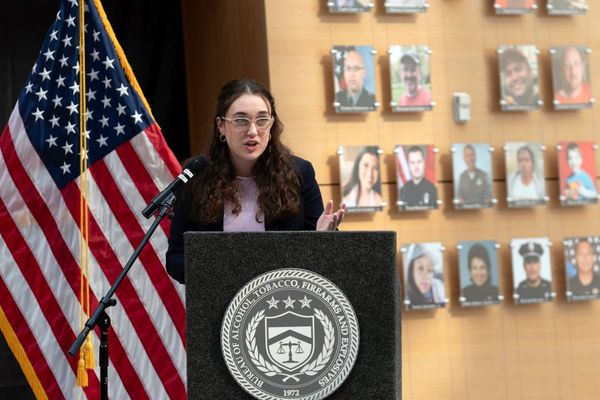
Australia’s immigration figures are not at record highs, migration experts say, rejecting claims aired at rallies on Sunday.
Experts say confusion about various migration numbers, and a recent case of inaccurate reporting which spread like wildfire online, have combined to give a false impression of overseas arrivals.
The government says Australia’s net overseas migration figure is actually down 37% from a recent peak, countering claims aired by those behind the weekend’s anti-immigration rallies.
How many people are coming to Australia?
There are several numbers relating to migration which are – correctly or incorrectly – bandied about: permanent migration, net overseas migration, and overseas arrivals and departures.
Abul Rizvi, former deputy secretary in the immigration department, and Prof Alan Gamlen of the Australian National University, said the most relevant number when considering the impact on housing and infrastructure – some of the concerns raised by protesters – was the net overseas migration figure, or NOM.
Sign up: AU Breaking News email
Federal government figures show the NOM for the 12 months to 31 December 2024 was 341,000 people. That’s down 37% compared to the NOM’s peak, of 538,000, in the 2022-23 year.
That record number, covering the period when Labor took office in May 2022, came after the former Coalition “stomped on the immigration accelerator” after the closure of Australia’s international borders during the Covid pandemic, Rizvi said, in a bid to make up shortfalls.
“Net migration is definitely falling, not rising – but it’s not falling as fast as Treasury is forecasting, and I don’t think it will fall as far,” Rizvi said.
Gamlen, director of the ANU’s migration hub, agreed migration was currently “not at a record level”.
“The trend of migration is steeply downwards” from recent highs, Gamlen said.
What were recent numbers?
We are still waiting for accurate NOM figures for more recent times. Rizvi said by mid-September, a more accurate picture would emerge. But while the latest figures are far from a record, other data from recent periods was much higher.
Between mid-2016 and early 2020, the NOM has hovered around 206,000 to 263,000 a year. But the Covid border closures saw NOM fall into negative territory for four straight quarters, with 95,000 more people leaving Australia than arriving in the year to March 2021.
After Covid restrictions eased in 2021 and 2022, the NOM soared. It hit 342,000 in the year to September 2022, then 433,000 in the year to December 2022.
“We know the trend is sharply downwards [from the peak],” Gamlen said. “We had a surge of arrivals after the pandemic to catch up when migration went in negative territory, but the arrivals catchup wasn’t big enough to make up for the shortfall.”
What did anti-immigration rally organisers say?
Information distributed by rally organisers said the march sought “an end to mass immigration”. Some material included claims that Australia was at a record high of immigration.
Such claims were supported by One Nation’s Pauline Hanson, who claimed on Monday that “the major parties keep ramping up immigration”.
One claim which spread online was that Australia was bringing in 1,500 new overseas arrivals each day. That claim was advanced by some conservative media outlets and picked up traction online among some supporters of the rally.
But Rizvi and Gamlen said the number was inaccurate, and a misunderstanding of migration figures. That figure, they said, referred to overseas arrivals and departures (OAD) data – which is more about tourist arrivals than migrants.
Media and online commentary about the issue led the Australian Bureau of Statistics to last week issue a stern rebuke and fact check, saying the use of OAD data “does not reflect the official ABS definition of migration and may lead to inaccurate conclusions on migration”.
OAD data “is a count of border crossings rather than migration. It is best used to understand patterns in traveller movements, such as tourism trends and seasonal travel,” the ABS said.
The bureau noted that someone on a temporary visa, who travelled in and out of Australia multiple times, would count as a visitor several times “even though they only migrated here once”.
Rizvi said the use of that number by migration critics was “nonsense”.
Are there other concerns about migration?
Migration was a key point of contention in the May election. Peter Dutton’s Coalition pledged deep cuts to permanent migration – another separate figure – and to cut the NOM by 100,000 below Labor’s figures.
Labor has said it wants to bring the NOM back below pre-pandemic levels. But its NOM for this year, usually contained in the federal budget, was not delivered with the March budget so close to the May election.
The number is expected soon, government sources say.
But Rizvi said the government would probably struggle to meet its own promise and projections. He said the only way to cut migration by a large enough amount would be to slash visas for partners of Australian residents, visas for overseas workers, or both – options he expected would be unpalatable to the government, on either a policy or a political level.
“There’s no easy way out. They’re all bad options,” Rizvi said.
What has the government said?
In parliament on Monday, the prime minister, Anthony Albanese, noted the decrease of 37% in the NOM.
He was responding to a question from MP Bob Katter, who spoke at the Townsville anti-immigration rally on Sunday. Katter claimed “400,000 people [were] coming from overseas each year”.
Albanese rejected Katter’s claims, responding: “I’m not sure what the basis of them are.”
“People in this country voted for a government that would understand that modern Australia was … a different nation than it was under the White Australia policy some time ago.”
Albanese added that “diversity is a strength in modern Australia”, saying migration presents an “incredible economic opportunity due to the diaspora here and their connections with every country on the planet”.
What effect does migration have on housing, infrastructure and the economy?
Gamlen said migrants were not to blame for Australia’s housing concerns. In fact, he said, it could be the opposite.
“House prices started booming in the middle of the pandemic, the end of 2020, when net migration was its lowest level in 100 years,” he said.
“It’s simply invalid to say this housing price boom was caused by net migration … Research shows the relationship between migration and housing is small and weak.”
Gamlen said migration may actually contribute to demand and supply, noting migrant workers were brought to Australia in construction trades.
“Some of them come in and build houses, and some are housebuilders. It evens out, migration is a small piece of the housing puzzle. Other issues with housing are to do with the problem,” he said.
Cutting migration numbers would also have an impact on foreigners coming to Australia on working holiday or student visas, who contribute to Australia’s economy, particularly the international education sector and businesses already struggling to find workers in a tight labour market.







